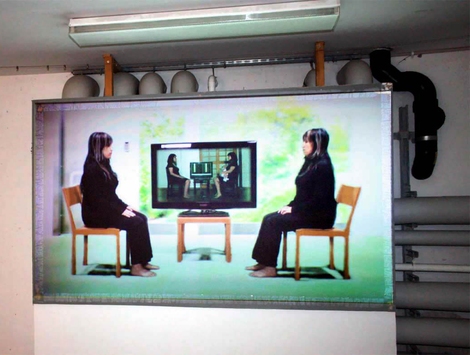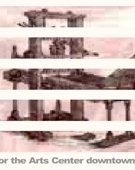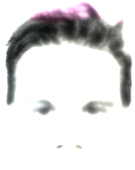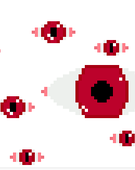(Interactive Videoinstallation)
Channel Distribution
CH1 (Channel 1) - moving in this area (left side of space) changes among scenes filmed in Lima & sentences spoken by me.
CH2 (Channel 2) - in this sector (right) the same action is repeated (reordering of sentences) but with a video recorded in Stockholm.
Full Description
The video itself consists of 3 layers of composite videos. The first two of these layers will be a sum of what we will call two video-recordings of myself talking apparently random sentences of what will later become a loose dialogue (when placed together), and the third consists of just me writing. First I appear with my daughter, breastfeeding, saying loose sentences (some of them questions) of what will later become the dialogue… I have repeated this action, without my daughter this time, and saying a different set of sentences (some of them answers). All of this “dialogue” has been written and filmed in Lima, Peru, in Spanish, but with English subtitles. The second layer (at first, within the T.V. as shown) is very similar: also a split image consisting of myself duplicated, saying loose sentences that later became a dialogue (or a mimicry of one), but this time filmed in Stockholm, Sweden (and the “dialogue” subsequently written in there). The subtitles shall be in Swedish in this case.
The different layers of cognition found within the mind are represented by the so-called channels, although the whole piece has different layers of meaning as well. I chose the term channel not only for its relation to television -due to the fact that, when one changes from one channel to another doesn’t mean that the original has stopped its transmission, just that we are not watching it anymore-, but also because the term refers to the intentional constrain within a certain path. Metaphorically, CHANNEL 1 and CHANNEL 2 represents the part of our thoughts we can still consciously access and modify, but the scene in which I am writing at the background, refers to that portion of our mind we cannot freely access nor change, but that behaves just as magma moving the tectonic plates that conform our consciousness.
Work metadata
- Year Created: 2011
- Submitted to ArtBase: Wednesday Apr 25th, 2012
- Original Url: http://cargocollective.com/autodios/Shifting-Channels
-
Work Credits:
- autodios, primary creator
Take full advantage of the ArtBase by Becoming a Member
Artist Statement
I view my mind as a group of processes occurring in heterarchical strata that actively interact among each other. Although influenced by theories concerning its splitting between different levels –being consciousness or alter/pre/sub/un-consciousness, etc.- I wouldn’t choose to tag or define each layer, nor pose a defined border on when one ends and the other starts; in this case, I am interested more in the interaction between those levels, and how self-awareness of this perception/cognition stratification can lead to quite complex inner dialogues and scene-(re)construction within one’s mind (brought up in the first place by more inner/deep drives, if one is to use psychoanalytic terminology): one can split oneself there and have an argument against that alter-self that has the ability of contradict “one’s” point of view; one can place oneself in one scenario or another, and all of this can be done in parallel, at the same time, or in an illogical time (some dreams appear to last extensively, and one just becomes aware on how short they really have been when one wakes up). The subjective nature of space-time within the mind appears to me as if it would behave sometimes as some sort of portal, having the ability to shift back and forth in space and time when recalling a memory (“re-living”), or experience existence in a parallel universe when dreaming a vivid dream. If there are contemporary theories in physics that postulate the existence of parallel universes in which every potential action we could have made at a certain point in time is actually happening, why not assume that it is really our consciousness/self-awareness taking just one of the multiple paths, being that what we end up perceiving as present, and maybe, what we would imagine that “could happen” if a different decision would be made, is actually just a way of accessing a potential future that is coming to be a reality in one of those parallel universes?
In 1963 the Argentinean writer, Julio Cortázar, published “Rayuela”, a book that had basically two different ways of being read: it could be read as a conventional book, from the first chapter to chapter 56, or reading chapters in the order he proposed, starting from 73, then going to the first one, then to the second, then to 116, and so on, until it ended in chapter 131. In this way he managed two write almost two books in one, since the whole meaning of each chapter changed due to the one read previously (and the ones omitted or added). In a way, it was not a static book as all the others; it was a changing book.
In this case, the idea is to portray a dialogue that could, at least, partially change its signification due to context (and randomization); with this I mean, depending of the sentence spoken before, the new one could have a slight or completely different meaning. Context will also influence the content of the dialogues: an analytic me is confronted to a motherly me in CHANNEL 1 (when situated in Lima); the dialogue of CHANNEL 2 will be related to nostalgia or longing, but what my drive will be when writing it I am not fully aware of by now: I need to be in Sweden by myself to be able to write it.
The phrases are translated to point out small (or big) differences between the original and the interpreted/translated; if someone can understand all the languages, well, maybe they will be able to notice this differences… If they were only able to speak one language of the three portrayed, they would be incapable of accessing the content of at least one of the two dialogues.





